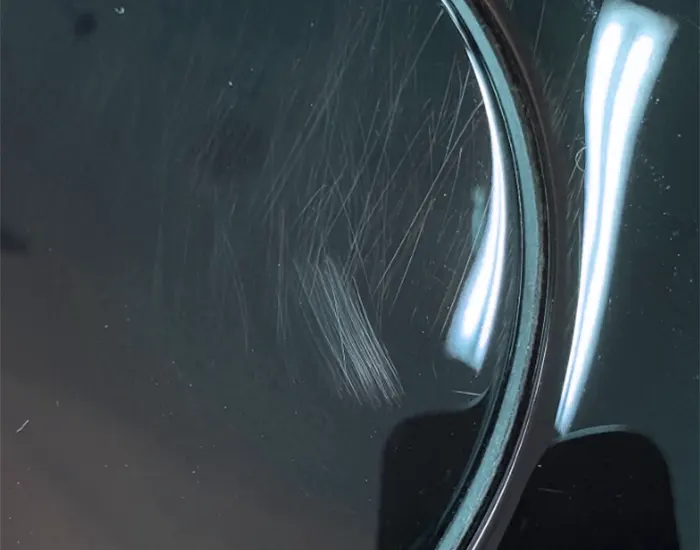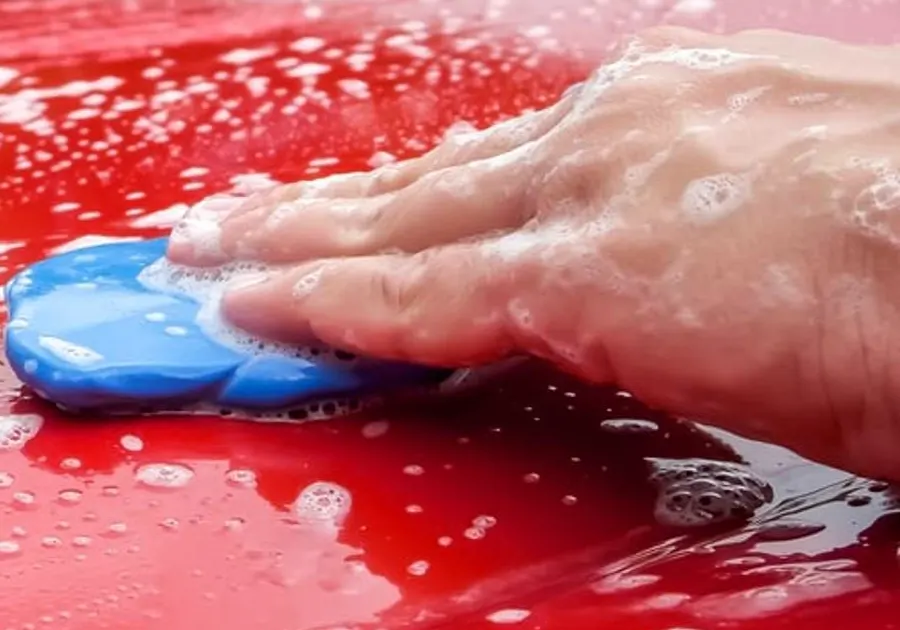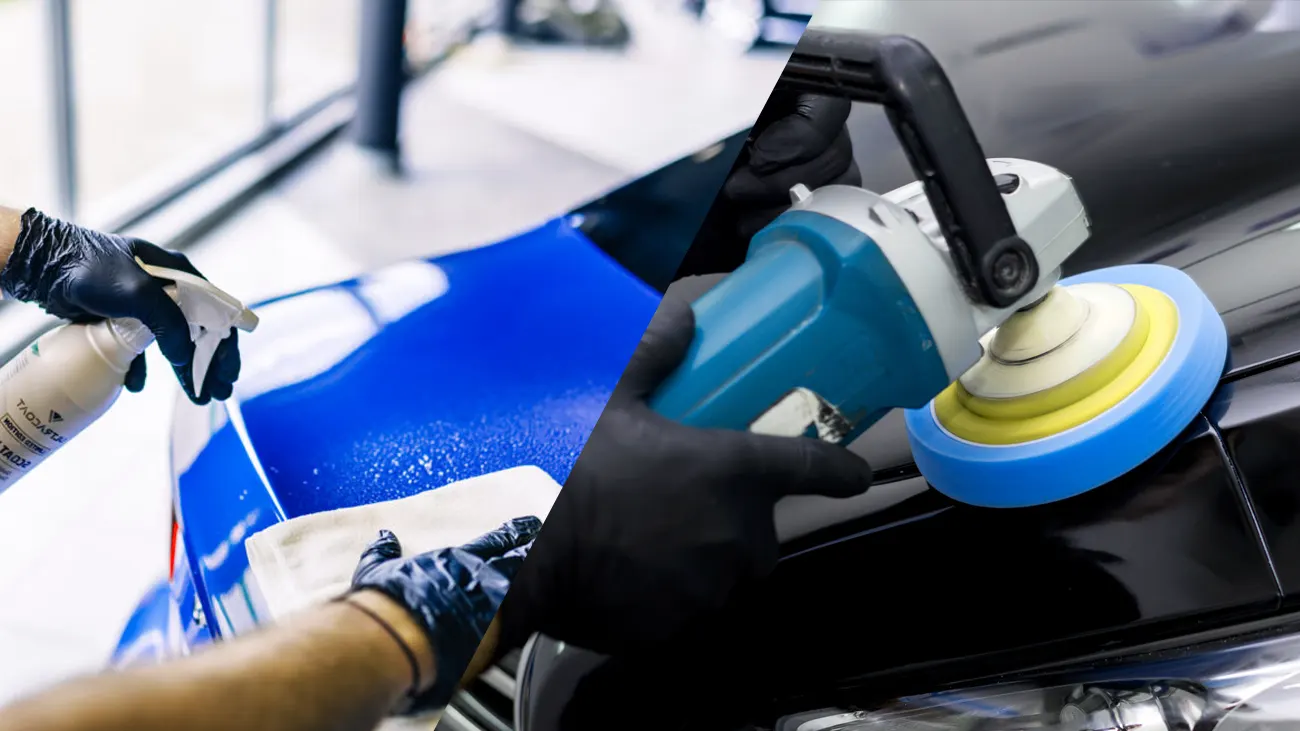After the ceramic coating is used for a period of time, some scratches will inevitably appear due to the complexity of the natural environment. Maintaining and repairing scratches on ceramic coatings is not a very complicated matter. Don’t be afraid to face it, we are all brave people. Let me share some problem solving methods and tips and everything will be fine.
How to Fix Scratches in Ceramic Coating?
We all know that graphene, wax, and ceramic coatings are all great ways to keep your car paint looking new. If you chose to have ceramic coating on your car in the first place, you were really smart. Because its service life is longer than wax, its ability to withstand sand and gravel on harsh road conditions is also stronger than graphene coating. However, even the toughest coatings will show flaws over time. What should you do when there are scratches on your ceramic coating? Although it greatly reduces the damage caused by external foreign objects to the car’s paint, scratches are still an eyesore and will affect the appearance of the car. Be worried, we have ways to repair scratches on ceramic coatings.
First we need to observe the size and depth of the scratches in the ceramic coating. Understand the actual type of scratches and then take appropriate remedial measures.
- Millimeter-level micro scratches:These are tiny, almost invisible scratches caused by daily washing, dirt particles or dust. Can only be seen under certain lighting conditions.
- Centimeter Medium Scratches:These scratches are longer and more noticeable than micro scratches, but have not yet affected the integrity of the underlying paint. Usually caused by brush, bird droppings, or minor scraping.
- Deep Scratches: These are the worst case scenario, these scratches go through the ceramic coating and touch the underlying substrate & paint. Failure to repair promptly can easily lead to corrosion and spreading damage. Usually caused by hard, sharp objects or accidents.

Repair ceramic coating scratches
How to repair micro scratches in ceramic coating?
For those barely visible scratches, there is no need for any complicated procedures. You can do the following:
- First, wash the affected area to remove dirt, grime, and residue.
- Apply a small amount of Ceramic Coating Special Polish or Nano Ceramic Coating to a microfiber towel or polishing pad.
- Gently buff the area by hand in a circular motion.
Be sure to polish gently and don’t overdo it or you’ll leave more swirl marks. What we will notice during this process is that as the polish fills in these tiny scratches, they disappear so quickly.
How to repair medium scratches in ceramic coating?
Repairing medium scratches is a little more complicated than micro scratches, but with the right tools and techniques, it shouldn’t be a problem.
- Clean and dry the affected area thoroughly.
- Because this scratch is more obvious, use a medium-strength polish, a touch-up pen, or a marker to fill in the scratch. Apply it to a microfiber cloth and rub with gentle pressure to work the polish into and around the scratched surface.
- Use a clean cloth to wipe away excess polish & touch-up pen.
- After polishing the scratches, reapply a layer of nano-ceramic coating. This step ensures that the surface is well protected after repair.
How to repair deep scratches on ceramic coating?
How to repair deep scratches on ceramic coating?
Because deep scratches have penetrated the ceramic coating and damaged the paint underneath, they require a thorough and complex procedure to repair.
- Like before, first wash and dry the scratched area thoroughly.
- Inspect the scratch again carefully. If the damage has reached the underlying paint itself, I do not recommend DIY paint repairs. Take your vehicle or item to a professional for paint repair before you treat the coating.
- Once the bottom paint is dry, use a polisher to buff the area. Because scratches of this magnitude are no longer small areas of polish, regional repairs will be faster with the help of a machine.
- Use a soft polish to polish the repair and remove any visible lines.
- Finally, apply a new coat of ceramic coating to the entire surface, making sure to completely cover the repair area.
As mentioned previously in our guide to applying ceramic coatings, give adequate curing time and environment. This restores the protective layer and ensures that the surface is as durable as before.
Causes and solutions for common problems with Ceramic paint.
It’is a common phenomenon that there are several factors can contribute to the failure of ceramic coatings. These factors can range from making mistakes during application to external environmental conditions that interfere with the coating’s curing process. It can help ensure the lifetime of your vehicle’s protective layer by recognizing these potential issues. After understanding these causes, our vehicle owners can take preventive actions to increase the life of their ceramic coating, and also maintain the vehicle’s aesthetic and protective qualities
Improper Surface Preparation
For many cars, it’s a vital and crucial step for applying ceramic coating to prepare the surface. If we don’t utterly clean and remove the surface’s dirt,so the coating won’t adhere properly. Contaminants like dirt, grease, or wax can create barriers ,then lead to prevent the coating from bonding with the paint.As time goes by,this improper bonding can cause early failure that may start to peel, flake, or develop imperfections.Therefore,to solve the problem,you need to be ready to prepare the surface.
Surface preparation often involves a detailed process that includes washing, claying, and sometimes even polishing. The aim of this action is to ensure that it’s pure on the surface. If you do not follow these steps or do it in a hurry, it may affect the coating effect.In addition, during preparation using the wrong cleaning agents or techniques can accidently produce new pollutants or damage the paint surface,and the process of application will also become complex.
Solutions:
- Wash the vehicle with a pH-neutral shampoo.
- Use a clay bar to remove embedded contaminants.
- Polish the surface to remove imperfections.
- Wipe the surface with an isopropyl alcohol (IPA) solution to remove any remaining residues.
– Use high-quality cleaning products designed for automotive surfaces.
– Work in a clean, dust-free environment to avoid contamination.

common problems with Ceramic paint
Poor Application Techniques
We should have knowledge of ceramic coating to avoid the poor application techniques . Inconsistent application can lead to coating failure, such as uneven layers or missed spots. It’s essential to follow the manufacturer’s instructions about regarding application techniques and drying times. Ignoring these guidelines can affect the final results that not only looks unsightly but also provides inconsistent protection across the vehicle’s surface.
Also, poor application can result if a low-quality applicator is used to apply the coating or the wrong type of cloth is used for polishing. It’s extremely easy for inferior tools to cause streaks, high spots, or other visual imperfections to appear.
Solution:
- Apply the coating in small patches (such as 2×2 feet) to ensure even coverage.
- Use a high-quality applicator pad and microfiber towel for smoothing and buffing.
- Follow manufacturer’s instructions for curing time and environmental conditions.
- Practice on a small or less visible area before applying paint to the entire car.
Environmental Factors
To ensure the best coating results, ceramic coatings should be applied in a controlled environment. Applying coatings in extreme temperatures and high humidity environments can cause improper adhesion or curing, and these results can reduce the durability and effectiveness of the coating.
In addition to temperature and humidity, there are other external factors such as dust, pollen, or other particles in the air that can fall onto the coating during the application process, causing it to become contaminated or uneven. In addition, it is best to check the local weather conditions in advance and plan the application. Under favorable weather conditions, it can greatly improve the success of the coating curing process.
solution:
- Apply the coating in a controlled environment (such as a garage or interior space).
- Maintain ideal temperature range (usually 50-80°F or 10-27°C) and low humidity.
- Avoid applying the coating in direct sunlight or windy conditions.
Inferior Product
Not all ceramic coatings are created equal. High-quality ceramic coatings are made from high-grade materials that ensure better adhesion, longevity, and resistance to various environmental factors. Conversely, inferior products fail to provide the protection or durability promised. I usually choose brands that are reputable, have good reviews, and work well. Going for the initial cost benefit may result in additional costs or repairs.
Solution:
- Use a reputable, high quality, trusted brand ceramic coating.
- Take the time to research products with proven performance, positive reviews, and professional recommendations.
- Avoid cheap or no-brand products that may compromise protection and longevity.
Lack of maintenance
Although ceramic coatings provide excellent protection for car paint, maintenance is still important. Many car owners tend to neglect maintenance resulting in the accumulation of contaminants and losing their hydrophobicity and glossiness over time. Therefore, we recommend cleaning your car regularly using the correct cleaning products and techniques. If you’re not in a hurry, you can inspect the coating for minor wear or damage during the cleaning process, allowing for prompt intervention and repair.
Solutions:
- Wash the vehicle regularly (every 1-2 weeks) using a pH-neutral car wash.
- Remove contaminants such as bird droppings or tree sap promptly to prevent staining.
- Use Ceramic Coating Maintenance Spray or top coat to restore hydrophobic properties.
How to remove ceramic coating?
Ceramic coating is popular among car owners because it can form a semi-permanent bond on the car surface to protect the vehicle’s appearance. However, keep in mind that ceramic coatings are not designed to be used permanently. Here are some reasons why you need to remove ceramic coating from your car:
Failure due to time.
As we mentioned earlier, ceramic coatings aren’t designed to last forever. Even the most professional ceramic coating that consists of 90%= SiO2 particles will wear over time, losing its sheen.
Want to know if your ceramic coating is failing? Check out these signs:
- Excessive accumulation of dirt and grime on your car surface
- Your car has begun to lose its luster
- The surface doesn’t appear sleek or slippery.
- You no longer notice water beads off. The surface stays wet when it encounters water
- The surface feels sticky to the touch
If you notice any of the above, the ceramic coating is beginning to lose its effectiveness. Of course, sometimes it may be because it is dirty. We can try to wash the car to see if it will recover. If the same problem still occurs after washing the car, it is time to apply a new coating.
Degradation.
Although the ceramic coating is resistant to bird droppings, water, UV rays and chemical attack. But like typical car paint, it doesn’t withstand heavy scratches. Why? Because the ceramic layer is only a few microns thick, making it is possible for scratches to penetrate the clear coat and leave unpleasant marks.
Poor Ceramic Coating Application.
Installing ceramic coating on a vehicle is not easy. A little carelessness can ruin the process. You can check out the basic steps of applying ceramic coating on our corresponding content, which I hope will help you. Here are common mistakes people make when installing ceramic coatings:
- Failure to properly clean and decontaminate surfaces;
- Untidy painting environment;
- Applying too much or too little product and not spreading it properly over the car’s surface;
- Forgetting to wipe off the coating after it flashes;
- Failure to wait for the coating to cure before driving;
While these errors are minor, they can lead to problems such as high spots, dirt, trapped contaminants, uneven thickness and reduced effectiveness of the coating. This will ruin the effect of your ceramic coating. Worse, once the ceramic coating dries, it becomes difficult to wipe it off, and it needs to be removed. If you are not confident in your skills, you can take your car to a professional.
Steps to remove ceramic coating from car.
Ceramic coating can be easily removed using a variety of techniques. But in order to achieve perfect removal results, you need to ask yourself a few questions before you start:
- How long has it been since the ceramic coating was applied?
- Are you going to apply a new ceramic coating after removing the old coating?
In addition to these, you should also pay attention to factors such as your comfort level and the problem surface (car exterior, plastic rims, glass, etc.). After we are mentally prepared, we can start practical operations. We should make preliminary work preparations.
Section 1: Gathering the Necessary Tools
Before embarking on the ceramic coating removal process, it’s essential to have the right tools at your disposal. Here are the tools you’ll need:
- Isopropyl Alcohol (IPA): This will serve as your primary cleaning agent.
- Microfiber Towels: Soft and lint-free microfiber towels are perfect for wiping off the coating.
- Clay Bar: A clay bar helps remove any remaining contaminants and provides a smooth surface for reapplication.
- Polishing Compound: If needed, a light abrasive polishing compound can be used to remove stubborn coating remnants.
- Dual Action Polisher: Optional but recommended for large surface areas or deep scratches.
- Protective Gloves: It’s important to wear gloves to protect your hands from chemicals and potential scratches.
Section 2: Prepare your vehicle

Clean cars
First, clean your car with a mild car wash to remove any dirt or debris from the surface. Rinse thoroughly and dry the vehicle completely with a microfiber towel.
Section 3: Section 3: Removing Ceramic Coatings
As I mentioned above, how long after the ceramic coating is applied is critical. Different removal methods will be used after different drying times.
For the situation where defects are found on the surface of the car paint less than 24 hours after it was just painted due to insufficient initial cleaning. Simply spray isopropyl alcohol or other paint degreaser on the area and wipe it with a rough rag to remove it.
For ceramic coatings that have been completely cured, more time and patience are required. There are generally two ways to remove hardened ceramic coatings: chemical removal and physical polishing.

Chemical removal versus physical polishing for ceramic coating removal
- Chemical Removal: We all know that ceramic coatings are very resistant to chemicals. However, its main resistance at the beginning of the design was against acids and salts, because acids and salts are the most common chemicals used in vehicles during daily use. So, when we use a degreaser with an alkaline product (opposite pH) it breaks the bond between the ceramic coating and the surface, making it easier to remove.
However, if you use a degreasing product that is too strong or leave it on the paint surface for too long, it can eat away at the underlying paint layer. Therefore, it is critical to properly dilute with water and control the corrosion time, and it is necessary to operate in conjunction with the instructions of the alkaline product. - Physical polish: Mechanical grinding of ceramic coatings using a polishing machine is the most common method and the most thorough way to remove it. We can use fine sandpaper (3000 grit) and an appropriate amount of lubricant to polish the surface until the polishing is satisfactory. If the coating is very thick and hard, it is recommended to use coarse sandpaper in the early stage, and then switch back to fine sandpaper after polishing.
Ceramic coatings help preserve your car’s paint, protecting it from elements that may dim its sheen or make it appear less appealing. However, like other paint protection, your ceramic coating will wear or get old, prompting you to remove and replace it. When that time comes, it’s important you stick to the methods discussed above for the best result.
Safety Precautions During the Removal Process.
Although removing ceramic coating may not involve extreme danger, it still requires a level-headed approach. There are a few precautions you should look after, which we will be discussing below.
Protective clothing and gear.
While not mandatory, it is highly suggested that you work with protective clothing and gear while working on the removal of your ceramic coating. A few things you can prepare and use are:
- Nitrile Gloves
- Respirator Mask
- Protective Glasses/Google
- Closed Toe Shoes
- Comfortable clothes that cover your skin
Ventilation and working in a well-lit area.
A mix of chemicals makes up the ceramic coating, so a well-ventilated workspace is the most important thing to keep you safe from intoxication. Your garage is an excellent workplace, but open those windows, fire up a fan, and let the fresh air in.
Working in a well-lit space is something to consider as well. Not only will it ensure precision, but also minimize the risk of accidental mishaps.
Common Issues During The Removal Process.
During removal, your car might encounter a few issues if you do not follow the preparation correctly.
Streaking or smearing after chemical removal:
Improper use of diluted alkaline solution, clay bar, or abrasive brushes might be the culprit to streaking or smearing after removal of the ceramic coat.
That is why it’s essential to do proper research before proceeding. Re-evaluate your technique, consider using only high-quality products, and maybe ask advice from a professional.
Ineffective polishing results:
If you do not do the polishing job correctly, you might have to redo it or, worse, have the paintwork re-done.
So, you should consider a few of these factors to avoid ineffective polishing results:
- Re-evaluate Products: You should ensure you’re using compatible polish because mismatched products can cause damage to your car’s paint.
- Check Applicator Tool: We’ve suggested what applicator pad to use when polishing your vehicle’s surface. It’s also important to check if the pad suits your chosen polish.
Damage to paintwork during mechanical removal:
While using machine polishing to rub the coating away works effectively on all kinds of coating, it’s still important to assess if there’s still a need to do it. The reason is that a car’s paint job can become easily damaged, even more so during mechanical removal. You can avoid this by using the correct product and applying the proper technique during mechanical removal (refer to the discussion above).
Maintaining your newly cleaned vehicle after removing the ceramic coating does not need professional or auto salon help. It is even by far the easiest part of the process! You can easily do it yourself with the help of a few recommendations.
- Regular cleaning routine:Establishing your regular cleaning routine for your car is the first key to keeping it well-maintained. We suggest you schedule at least one a week of cleaning to lessen the dirt pile up.
After creating a schedule, gather all the needed stuff and finish cleaning. Remember to do this carefully and only use high-quality products like microfibre towels and light scrubs. - Proper washing techniques: You can use many washing techniques for your car, such as two-bucket washing and special ceramic shampoos. These are just simple methods of cleaning that only require a few products, including a washcloth, soap or shampoo, and water!
One pro tip: Avoid going to automatic car washes as much as possible. Sometimes, their brushes can contain abrasive bristles that can easily scratch your car.
I believe that after reading this, you will have enough confidence to deal with worn ceramic coatings. When necessary, the old & severely worn ceramic coating can be removed according to the above method and re-coated with a new protective coating. If you are not confident in your hands-on ability or do not have enough time to handle it yourself, you can use the coatingsdirectory platform to find a ceramic coating studio near you to do it for you. Free up your time for spending time with your family.
FAQs
How much is ceramic coating on cars?
You can expect to pay around $1,000 to $3,000 to have a professional ceramic coating applied at a reputable beauty shop. The price of ceramic coatings is affected by a number of factors, so the price range is huge. Specific ceramic coating cost analysis can be found on our corresponding blog.
Does ceramic coating protect against uv?
Ceramic coatings are more than just a cosmetic enhancement; they are a formidable defense against the damaging effects of UV radiation. Their ability to absorb, reflect, and dissipate UV rays makes them a valuable asset for automotive paint, architectural surfaces, and more.
How often should ceramic coatings be maintained?
Regular maintenance cleaning is the cornerstone to maintaining the integrity of your ceramic coating. You can wash your car every 2 to 4 weeks using a pH neutral soap and the two-bucket method to effectively remove contaminants without damaging the coating’s protective layer. In addition, if conditions permit, it is recommended that the car be refurbished with ceramic coating every 2 to 5 years.

